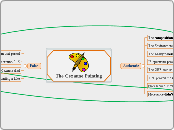によって Rana Khazbak 18年前.
479
The Cezanne Painting

The Cezanne Painting
Fake
IR indicates the presence of an underdrawing which, if true, would make the painting a fake
The IR spectroscopy indirectly shows the presence of cadmium and barium which were not used untill 2o years after Cezanne died
The UV spectrum test shows that the Polyene absorbance is 0.6 while it should be around 0.15
Not likely to be a 100 years old
The brushwork is indistinguishable from other paintings of Cezanne from that period
Authentic
Floresence didn't show any emission of Polyene
Florescence showed brighter emissions in dark green and orange areas which were similar to other Cezzane paintings
XRF proved the absence of cadium, barium, titamium and managanese which were not present in Cezanne period of time.
The XRF data showed that the painting composed of elements that were used during Cezanne period.
IR spectrum proves that the bider is animal glue-based which was used in Cezanne's period
The heavy palette knife strokes are specially characteristic of Cezanne's period
The Environment could contribute Polyene
The composition is very characteristic of his constructivist phase in the late 1880s

